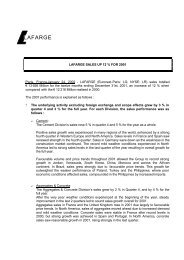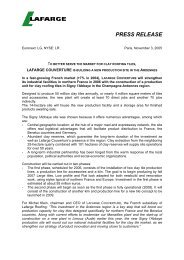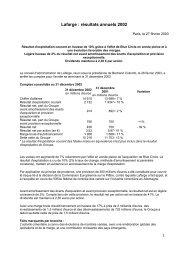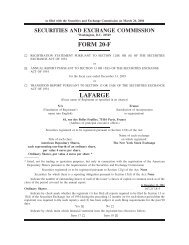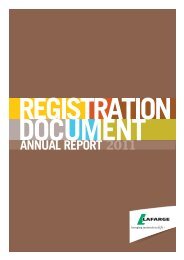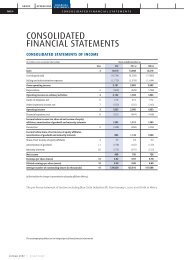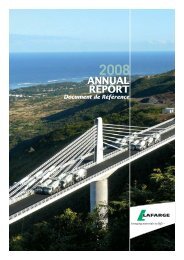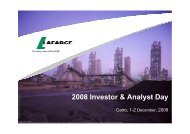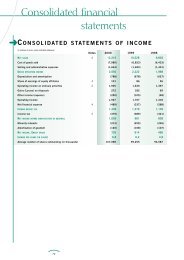2005 Sustainability Report - Lafarge
2005 Sustainability Report - Lafarge
2005 Sustainability Report - Lafarge
You also want an ePaper? Increase the reach of your titles
YUMPU automatically turns print PDFs into web optimized ePapers that Google loves.
Opinion of our stakeholders<br />
on the <strong>2005</strong> sustainability report<br />
The panel’s mission is to serve as “critical friends” who challenge <strong>Lafarge</strong>’s approach to corporate responsibility,<br />
suggest improvements and form each year an opinion on <strong>Lafarge</strong>’s accountability. However they do not verify the data<br />
or deliver any kind of assurance on performance.<br />
Overall, we consider that <strong>Lafarge</strong>’s<br />
sustainability report has improved over<br />
the years. We especially appreciated the<br />
comprehensive information provided on<br />
lobbying, Clean Development Mechanisms,<br />
sustainable construction, HIV, corruption<br />
and the tsunami. Most of us find the report<br />
reader-friendly and well structured, although<br />
positioning most indicators exclusively in<br />
a dedicated part rather than in the main<br />
text may complicate the understanding.<br />
However, one member encouraged more<br />
tangible examples and a less abstract<br />
language, while another called for more<br />
concise text and data in the management<br />
section. More generally, we noticed instances<br />
of vague wording and unsupported claims.<br />
To improve on this despite space constraints,<br />
we suggest referencing online annexes, as<br />
well as more precision wherever possible.<br />
We welcome the inclusion of new indicators,<br />
e.g. on purchasing, top managers’ appraisals,<br />
etc.; however for social and economic data,<br />
such as on restructuring, we would<br />
appreciate a breakdown by business or<br />
by country. We also appreciate <strong>Lafarge</strong>’s<br />
candor regarding a drop in performance<br />
in certain areas, e.g. safety and air<br />
emissions, or a gap versus peers, e.g.<br />
ISO 14001 certification; that said, we were<br />
disappointed to find few explanations of<br />
the causes and little discussion of potential<br />
remedial action.<br />
We would also welcome further discussion<br />
of how acquisitions have affected risk<br />
exposure and variations in performance in<br />
these areas. For example, <strong>Lafarge</strong> mentions<br />
its acquisitions in China but the related<br />
social and environmental challenges are<br />
CONTACTS<br />
Senior Vice President<br />
sustainable development<br />
and public affairs<br />
Olivier LUNEAU<br />
olivier.luneau@lafarge.com<br />
Vice President environment<br />
Michel PICARD<br />
michel.picard@lafarge.com<br />
Vice President social policies<br />
Patrice LUCAS<br />
patrice.lucas@lafarge.com<br />
Vice President investor relations<br />
Yvon BRIND’AMOUR<br />
yvon.brindamour@lafarge.com<br />
PAGE 50 | LAFARGE | AVRIL 2006 | RAPPORT DÉVELOPPEMENT DURABLE<br />
not discussed. We would like to know more<br />
about the measures taken to fulfill group<br />
commitments to international norms and<br />
standards. Finally, we feel concerned with<br />
the continued lack of reporting on<br />
emissions of Persistent Organic Pollutants.<br />
Regarding performance, we appreciate the<br />
progress on labor issues and operational<br />
environmental impacts, but we consider<br />
that the group still has to step up in two<br />
areas: water strategy and impact on local<br />
communities. Here, we would like to see<br />
data covering major impacts on employees<br />
and their dependents, suppliers, etc., from<br />
settlement to site closure and rehabilitation,<br />
especially in Southern countries. Beyond<br />
indicators, the report would benefit from<br />
short case studies with references to more<br />
detailed local reports available online.<br />
Finally, some short-term corporate targets<br />
need to be completed by more long-term<br />
goals, especially on global carbon emissions,<br />
given the expansion in booming economies<br />
such as China.<br />
In the future, it will be important to<br />
strengthen the link between product<br />
performance, which is impressive, and<br />
improvement of building performance -<br />
thanks to lifecycle approaches, collaboration<br />
with other industries, raising customer<br />
awareness and accountability on product<br />
end-of-life.<br />
Regarding assurance, we welcome the audit<br />
of selected KPIs and look forward to<br />
receiving the results of the social audits<br />
mentioned (page 35). For coming years, we<br />
support this kind of third-party audit, as<br />
well as the involvement of concerned<br />
stakeholders. Benchmarking against peers<br />
Senior Vice President<br />
Group communications<br />
Philippe HARDOUIN<br />
philippe.hardouin@lafarge.com<br />
Vice President<br />
Group external communications<br />
Stéphanie TESSIER<br />
stephanie.tessier@lafarge.com<br />
Managing editor: Stéphanie Tessier • Design and production: Direction de la communication <strong>Lafarge</strong> /<br />
Skipper Communication • Editorial team: Ernst&Young • Graphic design :<br />
Production: HMS Publications • Photo credits: D.R. Médiathèque <strong>Lafarge</strong>, Longrine, Images et Concepts/<br />
Laurence Prat, Thomas Mayer, Rapho/ Gérard Uferas, ©Jacques Ferrier architecte, Rapho/Niang Zeng,<br />
D.R. <strong>Lafarge</strong> Zement GmbH, R. Lowery / Ernest Rawlins, ©Dessin AAT BOGAERT, Rodrigo Gomez,<br />
Michel Monteaux, Agustinus Sidarta Photography • Illustrations: Picotto.<br />
is another very positive element and needs<br />
to be further developed through the<br />
comparison with best practices from other<br />
industries. We would also be happy to see<br />
<strong>Lafarge</strong> actively lead the development of<br />
a cement- sector specific supplement to<br />
the GRI guidelines, in collaboration with<br />
stakeholders. Finally, we suggest that future<br />
reports address the emerging materiality<br />
of issues such as carbon and sustainable<br />
construction through clearer discussion of<br />
how they are integrated into decision<br />
making and how financial and sustainability<br />
performance are linked.<br />
Members of the panel<br />
Patrice Ponceau (European Works Council)<br />
• Marion Hellmann (Building and Wood<br />
Workers International) • Jean Paul<br />
Jeanrenaud (WWF) • Philippe Lévêque<br />
(CARE) • Karina Litvack (F&C Asset<br />
Management) • Cornis van der Lugt<br />
(UNEP) • Livia Tirone (Architect) • Alastair<br />
McIntosh (Centre for Human Ecology) •<br />
Simon Zadek (AccountAbility) • Chaired<br />
by Elisabeth Laville (Utopies)<br />
Headquarters<br />
61, rue des Belles Feuilles - BP 40<br />
75782 Paris Cedex 16 - France<br />
Phone: + 33 1 44 34 11 11<br />
Fax: + 33 1 44 34 12 00<br />
www.lafarge.com




